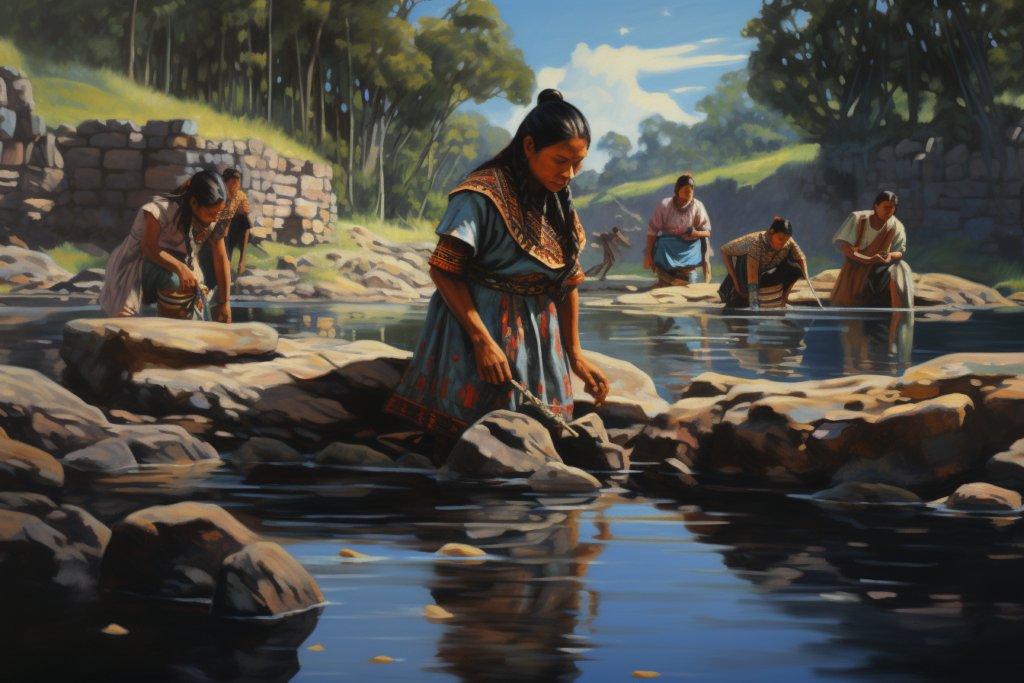Mexico Story
Water Nourishes the Heart of Culture
Since time immemorial, Water has sustained indigenous communities and has a great significance in their culture.
Water as source of life, stories, traditions, and ancestral practices symbolized a continuity of ties among the forty-nine participants representing Pueblo, Maya, Zapotec, Quechua, and other cultures in Mexico in a three-day cultural exchange.
What better way to appreciate this elemental force than in immersing and understanding the various peoples’ regard and utilization of water? They learned of the Maya’s Chultuno’ob or ancestral water management; they savored the Tejate’s traditional zapotec beverage; they learned about the Tsotsil’s corn and water cycles; and listened to the Water stories told inside a cenote and peeked into traditional water vessels. A participant reflected and said, “I learned that the cenotes were sources of precious water, and continue to be spiritual places for the Maya who greatly value them.”
The participants, through the able guidance of Maya elders and youth involved in cultural preservation beheld the beauty and majesty of the Maya’s ancestral sites and learned about Maya epigraphy (glyph writing) and song on rain and water. “The opportunity to know first-hand and so intimately several ceremonial places was very important. It helped me understand the value of preserving and honoring our culture,” said one participant.
Priceless and awe-inspiring for the participants were the retracing of historic trade routes, retelling of migration stories and how ancestors sustained cultural and natural resources, cultivated their native languages, and ancestral knowledge systems including use of their medicinal plants, textiles and basket making, and stone architecture, and storytelling with elders.
The Cultural Conservancy sponsored a Media Training for the youth who were taught videography and photography to produce a video on the importance of water from ceremonial and sustenance perspectives. A participant shared a poignant memory: “While doing a video shoot, rain water fell with all its might and we drank the water running off the leaves. Amazing too was the torrential rain at Ek Balam. Strong rains came and surprised us, trapping us on top of the pyramid. It was incredible to feel the power of the wind, rain, thunder and how nature responded to our prayers for water.” Another keen observation was shared by two other participants. The first said, “It’s good to learn that the Pueblo people have rain ceremonies, and this made us all come closer together as people of this Earth. I appreciated knowing that other people in Mesoamerica share the same ritual and daily living practices related directly to nature and the land.” The other participant was moved by the natural power of rain to conclude that “The rain is always a giver of life; it must never be seen as a weather problem or inconvenience. We are the ones who have to adapt to it and not expect the rain to adapt to our lifestyle.”
The other rich experiences gained were the youth learning to fuse ancestral home construction techniques into their architecture courses and a grant being awarded by the First Nations Development Institute for a design on food sovereignty assessment for one of the Pueblos. There are plans to establish cultural centers in New Mexico, Yucatan and Oaxaca. There were plans to develop a calendar on all the cultures’ corn cycles, cultural astronomies and worldviews. Gardens are being planted with traditional crops in New Mexico and Guatemala, and they are reviving the endangered ancestral practice of raising the insect that has been, for centuries, the source of natural carmine pigment.
The cultural exchange of the youth and elders from various indigenous groups in Mexico tightened their ties, deepened their knowledge and understanding of their past to protect the legacy for the coming generations, and fostered action-oriented plans. The activity enhanced leadership skills in the youth who learned about each other’s cultural values and gained a greater appreciation of their own native identities and traditions. A participant shared that the exchange “…helped to clarify about what I am to do with my life. The experience awakened my inner leader, and generated a commitment to keep fighting.”
The gathering was deeply inspiring and re-affirming of cultural identity. It strengthened links among the cultures such that a participant reflected, “Each time I visit a new place in my home state of Yucatan, I feel my own culture becoming enriched by the mere fact that I am with my people. To be in Saki (Valladolid) makes me so proud, and I gained new knowledge. When I was there for several days, my thoughts started to mingle with nature, with other cultures present. The experience made me value my identity and strengthened me to keep sharing my experience and culture with my friends and family.”
The participants realized not only the need to sustain interactions among themselves, but also to have a consistent source of funding to support the establishment of local learning centers to benefit more communities. Cultural exchange among indigenous people is encouraged to continue to link their common histories and motivate the youth to launch new initiatives on cultural preservation.
As water is life-sustaining, it is likewise altering worldviews of the indigenous youth in Mesoamerica. One participant concluded, “In our indigenous homelands, water is still in its natural setting in rivers, lakes, cenotes, and we have direct contact with water, drinking it directly from source. In the western world, people are only aware of water coming out of the tap or the shower, and have no direct contact with its source that exists in the indigenous world. Indigenous people value water in a deeper way.”
Native Youth and Elders Cultural Exchange Gathering: The Fourth Maya – Pueblo Youth Cultural Exchange took place in Zací, Yucatán, México on August 05-13, 2015. The project was implemented by the Yakanal or Indigenous Youth Cultural Exchange with the support of PAWANKA Fund.

